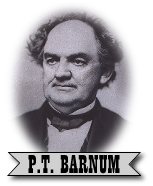

 |
 |
 |
 |
| Phineas Taylor
Barnum
was born July 5, 1810,
in Bethel, Conn., the first child of Philo Barnum and his second wife, Irene
Taylor. In 1826, after his father died, Barnum began a job as a clerk in a general store
in Brooklyn, NY, where he first became enthralled with the grandeur and excitement of the
city. He married Charity Hallet in 1829 in Bethel, and soon became engaged in promotion,
press manipulation and show business. After touring the country with various entertainers,
he established Barnum's American Museum in the center of old New York. It became one of
the most spectacular buildings in the city. Barnum's first major success was the
introduction of General Tom Thumb in 1842. Within two years, they embarked on a tour of
Europe. His ultimate affiliation with the circus did not begin until 1870, when he was 60
years old. P. T. Barnum's Grand Traveling Circus, Menagerie, Caravan and Circus grossed
$400,000 in its first year. Living in Bridgeport with his second wife, Nancy Fish, Barnum
became mayor of the city in 1875 and served a single one-year term. In 1877 and 1879, he
was elected to represent Bridgeport in the Connecticut General Assembly. He lost a third
term in 1880. In 1887, Barnum invited James Bailey to join him as an equal partner in the
new Barnum and Bailey Circus. Two years later, he took the "Greatest Show on
Earth" to England.
************************************************************************************************************
East Bridgeport was P.T. Barnum's "pet" project. He wanted to remind anyone who passed
through the East Side that he had planned the district. There's Barnum Avenue;Hallet
Street(the maiden name of his first wife,Charity); and Caroline, Helen,and Pauline
streets, named for three of his daughters. Noble Avenue is named for the Barnum's land
developer partner, William Noble. In 1851, five years after Barnum took up residence in
the city following his discovery of Charles Stratton(Tom Thumb), Barnum purchased a tract
of farmland from Noble.
************************************************************************************************************
B arnum constantly looked for ways to beautify Bridgeport. In 1863, he proposed that Bridgeport's shore on Long Island Sound, at that time strewn with rocks and boulders, should be cleared out, opened along the entire waterfront, and transformed into a park. He predicted that such an improvement would increase the taxable value of the property in the area, enrich the city treasury, be an attraction to visitors, and increase development. Barnum felt that " it dwelt upon the absurdity, almost criminality, that a beautiful city like Bridgeport, lying on the shore of a broad expanse of salt water, should so cage itself in that not an inhabitant could approach the beach." In 1866 , with Barnum's wife's health declining a physician recommend that the family move nearer to the seashore. Barnum's first house. Iranistan, had burned to the ground in 1857. A few years later he built his dream house, the elegant Lindencroft, which was adorned with statuary and fountains, trees and shrubbery and beautiful flowers. Lindencroft was sold July 1,1867. He moved into his completed house Waldemere(Woods by the sea) in June 1869, another house built with the highest in comfort. ************************************************************************************************************B arnum was truly one of Bridgeport's first progressive mayors, fighting for numerous public improvements. Even in the last years of his life Barnum never lost his enthusiasm for a masterful publicity stunt. One of his last Bridgeport's gimmicks took place in 1888. The Stratford Avenue Bridge was replaced by a new iron structure and Barnum assured everyone of its safety by parading twelve elephants weighing thirty-six tons onto the bridge. In the Fall of 1890, a stroke confined Barnum to his home. In his final letter to his partner James Bailey, the Greatest Showman on Earth reflected on his career. Barnum died five days later on April 7,1891. In 1948, so that Barnum's "kind acts may live forever," Bridgeport saluted the showman with the Barnum Festival, an idea generated by Bridgeport Brass executive Herman W. Steinkraus. It includes the King and Queen event, The Jenny Lind concert, The Tom Thumb competition, and numerous other special features, capped by the grand parade, all saying thanks to the Greatest Showman on Earth & Bridgeport's first citizen
|